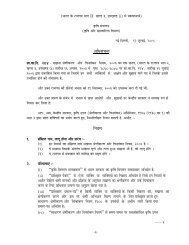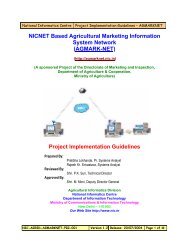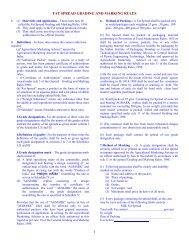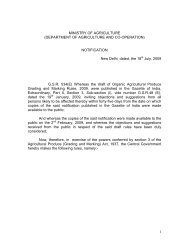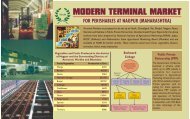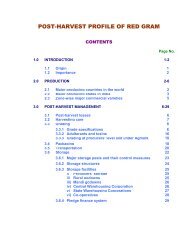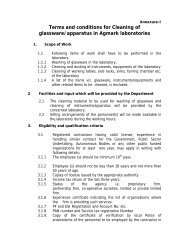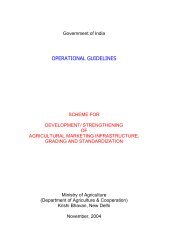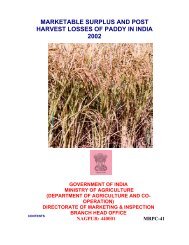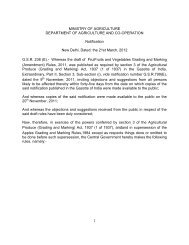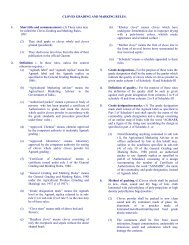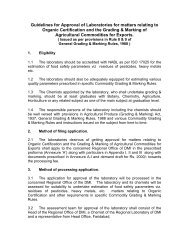Marketed Surplus and Post-harvest Losses of Jowar - Agmarknet
Marketed Surplus and Post-harvest Losses of Jowar - Agmarknet
Marketed Surplus and Post-harvest Losses of Jowar - Agmarknet
Create successful ePaper yourself
Turn your PDF publications into a flip-book with our unique Google optimized e-Paper software.
S<br />
.<br />
N<br />
o<br />
.<br />
1<br />
.<br />
2<br />
.<br />
3<br />
.<br />
4<br />
.<br />
5<br />
.<br />
TABLE NO. 2<br />
MARKETABLE SURPLUS RATIOS OF SELECTED CEREALS<br />
Commodity Marketable<br />
surplus ratio<br />
(Percentage)<br />
Year <strong>of</strong><br />
reference<br />
Paddy 1 8.87 1972-73 1979<br />
Wheat 2 65.10 1973-74 1986<br />
<strong>Jowar</strong> 3 33.14 1974-75 1984<br />
Bajra 4 36.31 1974-75 1985<br />
Maize 5 30.86 1974-75 1987<br />
Year <strong>of</strong><br />
publication <strong>of</strong><br />
report<br />
2.3 This apart, micro studies are being undertaken in the Agricultural Universities <strong>and</strong> Research<br />
Institutes. Some <strong>of</strong> these findings with regard to marketable surplus & post <strong>harvest</strong> losses are<br />
furnished below :<br />
• The World Bank Operations Evaluation Study <strong>of</strong> (1974-85) 7 reported the storage losses <strong>of</strong><br />
Sorghum <strong>and</strong> Millet as 4% in Nigeria <strong>and</strong> 1.7% in Malavi.<br />
• Khadse, et al. 8 studied the marketable surplus <strong>of</strong> kharif jowar in Vidarbha Region <strong>of</strong> Maharashtra<br />
<strong>and</strong> reported the marketable surplus <strong>of</strong> 7.22% in small category, 22.79% in medium category,<br />
42.66% in large category <strong>and</strong> 29.77% as overall average. The study further concluded that the<br />
production <strong>of</strong> jowar, marketable surplus <strong>and</strong> marketed surplus were having positive relationship<br />
with the size <strong>of</strong> holdings. Whereas the retentions for kind payment <strong>and</strong> home consumption were<br />
having negative relationship with the size <strong>of</strong> holding. In small <strong>and</strong> medium size holdings, the<br />
distress sale was found. They further concluded, “the major factor governing marketable surplus<br />
was being production <strong>and</strong> that home consumption <strong>and</strong> kind payment were responsible to reduce<br />
the marketable surplus <strong>of</strong> jowar in the area studied”. It may be mentioned here that jowar is a<br />
major staple food in the area <strong>of</strong> study conducted by the researchers.<br />
• Pawar P.P. et al. (1990) 9 reported that the marketable surplus <strong>of</strong> jowar was positively related to<br />
size <strong>of</strong> holdings in Marathwada region <strong>of</strong> Maharashtra. The study concludes that the distress sale<br />
<strong>of</strong> both rabi <strong>and</strong> kharif crop was found in case <strong>of</strong> small cultivators due to their urgent needs <strong>of</strong><br />
cash requirements. This is in conformity with the conclusions <strong>of</strong> the Khadse et.al. as indicated<br />
above.




